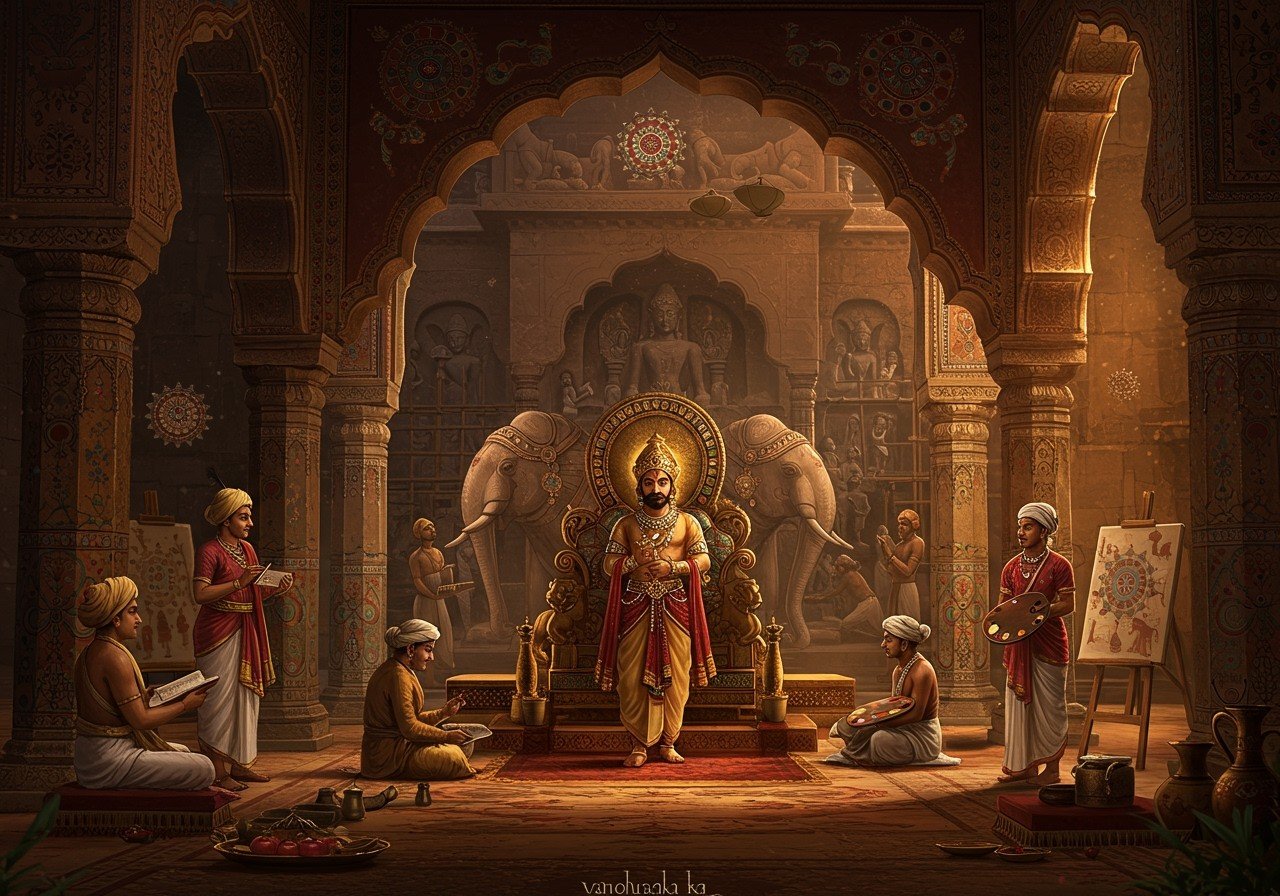
The Vakataka Dynasty, a prominent chapter in Indian history, significantly shaped ancient India’s cultural and political landscape. This blog delves into the dynasty’s rise, decline, and enduring legacy, emphasizing its contributions to art, architecture, and governance. We’ll explore the dynasty’s origins, historical context, and the remarkable figures who guided its trajectory.
What was the Vakataka Dynasty?
The Vakataka Dynasty was a powerful Indian dynasty that reigned over parts of Central and Southern India between the mid-3rd century and 5th century CE. Their empire stretched from Malwa and Gujarat in the north to the Tungabhadra River in the south, and from the Arabian Sea in the west to the Bay of Bengal in the east. The Vakatakas, claiming Brahmanical origins, are renowned for their sophisticated socio-political structure, efficient administrative and military strategies, and significant contributions to India’s art and architecture, notably their patronage of the Ajanta Caves. Their reign witnessed the flourishing of both Buddhism and Hinduism, marked by support for various religious activities and the construction of numerous temples and monasteries. This era of blended cultural practices solidified the Vakataka period’s importance in India’s history.
Who Founded the Vakataka Dynasty?
Vindhyashakti I founded the Vakataka Dynasty in the mid-3rd century CE. His name, symbolizing strength and stability, reflects his role in consolidating territories and establishing robust governance. His successors, Pravarasena I and II, further expanded the empire, forging alliances and matrimonial ties with other dynasties to enhance their influence. These rulers laid a solid foundation for prosperity and growth within the Vakataka realm.
The Cultural Flourish under the Vakataka Dynasty
The Vakataka Dynasty is celebrated for its remarkable contributions to Indian art and architecture. Their most significant achievement is the patronage of the Ajanta Caves, a UNESCO World Heritage site. These caves showcase exquisite mural paintings and sculptures depicting Buddhist teachings and scenes from everyday life. Literature also prospered during this period, with poets like Kalidasa producing renowned works under Vakataka patronage. The rulers fostered religious tolerance, allowing Buddhism and Hinduism to coexist harmoniously.
The Decline of the Vakataka Dynasty
The downfall of the Vakataka Dynasty was marked by internal strife and external pressures. Succession disputes weakened central authority, while invasions by the Gupta Empire and other neighboring powers further destabilized the region. The final years witnessed a decline in power and influence, impacting the socio-economic fabric of regions previously under Vakataka control and ushering in changes in governance and culture.
Which Dynasty Came After the Vakataka Dynasty?
Following the decline of the Vakataka Dynasty in the 5th century CE, several regional powers emerged. The Chalukya Dynasty rose to prominence in the Deccan region, bringing political and cultural shifts, including advancements in architecture and administration. The Vakatakas’ legacy continued to influence subsequent dynasties in the region, who adopted some of their governance practices and cultural traditions.
Enduring Legacy of the Vakataka Dynasty
The Vakataka Dynasty left an indelible mark on Indian history and culture. Architectural marvels like the Ajanta Caves continue to attract scholars and tourists worldwide. Literary and artistic achievements from this era influenced later generations. The dynasty’s contributions to Indian governance, including administrative practices and legal reforms, remain significant. Their role in fostering inter-dynastic alliances and cultural exchanges further solidified their place in history. The Vakataka heritage continues to resonate in contemporary Indian society.
Connecting with the Vakataka Legacy through Ritual Items at Poojn.in
Poojn.in offers a unique opportunity to connect with the rich spiritual heritage of the Vakataka Dynasty period. Explore authentic ritual items, like the Vamavarti Shankh (left-turning conch shell), which holds deep spiritual significance and is used in various Hindu ceremonies, reflecting the sacred traditions practiced during the Vakataka era. Poojn.in provides genuine ritual materials with detailed product descriptions and usage guidelines, empowering you to maintain traditional practices and honor the spiritual legacy of ancient Indian dynasties.
Conclusion
The story of the Vakataka Dynasty is one of resilience, cultural vibrancy, and enduring influence. Despite its eventual decline, the dynasty’s contributions to art, architecture, and governance remain significant. The Ajanta Caves stand as a testament to their artistic vision, while their administrative practices shaped future rulers. The Vakatakas’ support for religious tolerance and cultural exchange fostered a diverse and flourishing society. Their legacy continues to inspire and enrich India’s cultural and historical tapestry, reminding us of the depth and complexity of India’s rich past.
FAQs on the Vakataka Dynasty
What defined the Vakataka Dynasty?
The Vakataka Dynasty was an ancient Indian ruling house originating in the Deccan region around the mid-3rd century CE, known for its Brahmanical origins and contributions to art, architecture, and governance.
Who established the Vakataka Dynasty?
Vindhyashakti I founded the dynasty, consolidating territories and establishing strong governance, later succeeded by Pravarasena I and II who expanded the empire.
Which dynasty succeeded the Vakatakas?
Following the Vakataka Dynasty’s decline in the 5th century CE, the Chalukya Dynasty rose to prominence in the Deccan region, introducing political and cultural shifts.
What were the Vakataka Dynasty’s key accomplishments?
The Vakatakas are renowned for their patronage of the Ajanta Caves, contributions to art and architecture, and their role in the flourishing of both Hinduism and Buddhism.
Where was the Vakataka Dynasty situated?
The dynasty was primarily located in the Deccan region, spanning parts of modern-day Maharashtra, Madhya Pradesh, Andhra Pradesh, Gujarat, from the Tungabhadra River in the south to Malwa and Gujarat in the north, and from the Arabian Sea in the west to the Bay of Bengal in the east.
How did the Vakataka Dynasty gain power?
The Vakatakas ascended through strategic alliances, military conquests, and the consolidation of territories under Vindhyashakti I’s leadership.
What led to the Vakataka Dynasty’s decline?
Internal conflicts, weakened leadership, and invasions from neighboring dynasties, including the Gupta Empire, contributed to their downfall.
What is the lasting impact of the Vakataka Dynasty?
The Vakatakas left a lasting legacy through their artistic and architectural achievements, particularly the Ajanta Caves, their contributions to Indian culture, and their influence on subsequent dynasties in the Deccan region.


